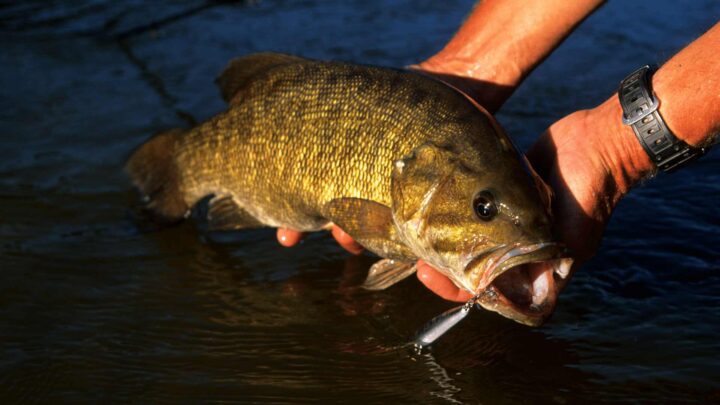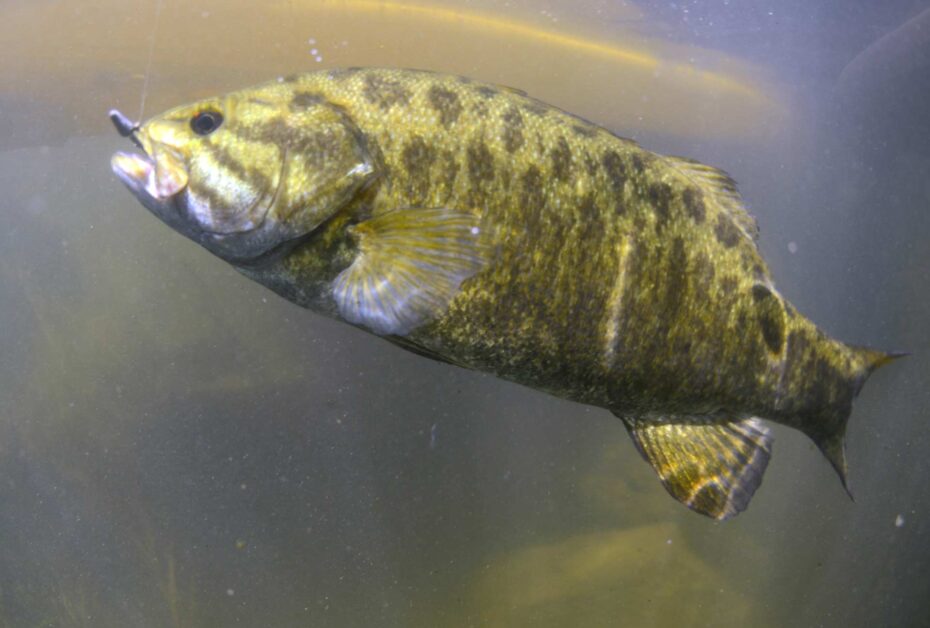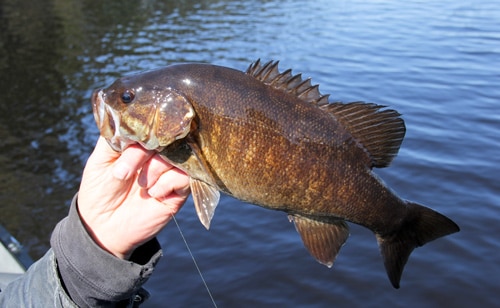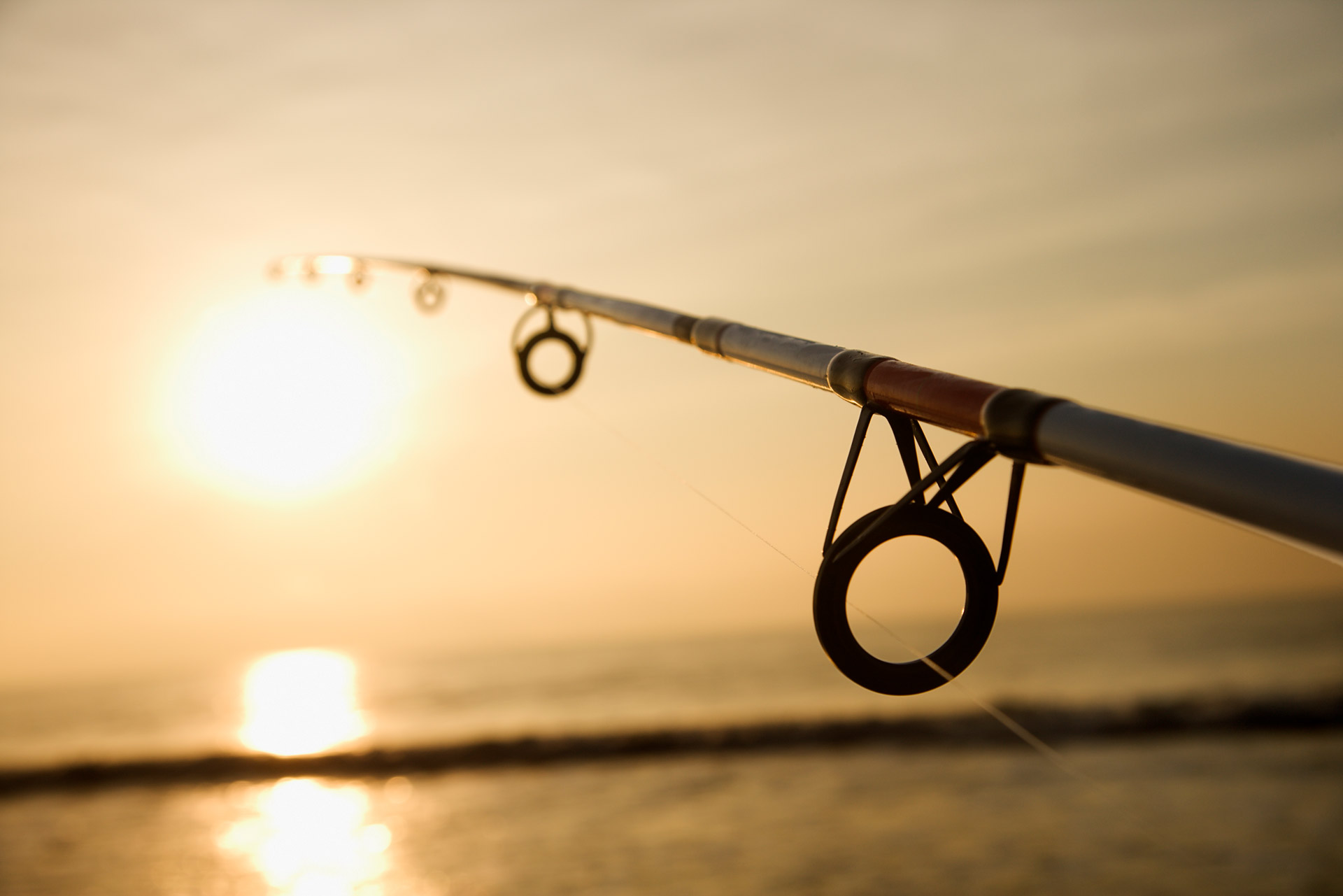Master the Art of Smallmouth Bass Fishing with These 10 Proven Tips

As an angler, nothing quite beats the thrill of reeling in a smallmouth bass.
Their strength, agility, and feisty nature make them one of the most exciting fish to catch.
But let's face it, even the most skilled fishermen can have a tough time when it comes to catching these elusive creatures.
That's where we come in. In this blog post, we will share with you the best smallmouth bass fishing tips that will help you catch more smallies on your next fishing trip.
Whether you're a seasoned pro or a novice, these tips will give you the edge you need to land more smallmouth bass.
So, grab your fishing gear, pack your bags, and get ready to reel in the big ones!
Understanding Smallmouth Bass
Understanding Smallmouth Bass is crucial for any beginner angler looking to catch this popular game fish.
Smallmouth bass, also known as "bronzebacks," are found in clear, cool, and rocky waters across North America, making them a popular target for fishing enthusiasts.
They have a distinctive look, with a greenish-brown back and a white belly, and can grow up to 20 inches in length and weigh up to 6 pounds.
Smallmouth bass are known for their aggressive nature, making them a challenging fish to catch.
To increase your chances of success, it is important to understand their behavior, habitat, and feeding habits.
By doing so, you can effectively select the right equipment and lures, and develop a strategy to catch these prized fish.
Characteristics of smallmouth bass

Smallmouth bass are a popular game fish in North America and catching them can be a thrilling experience. Understanding their characteristics is key to catching them successfully. These are some key characteristics of smallmouth bass:
- Smallmouth bass are typically olive-green in color with dark brown vertical stripes.
- They prefer cooler water temperatures and can be found in both lakes and rivers.
- Smallmouth bass are known for their fighting spirit and can put up a good fight when caught.
- Their diet consists of smaller fish, insects, and crustaceans.
- Smallmouth bass are often found near rocky structures or underwater ledges.
Knowing these characteristics can help you choose the right bait and location to catch smallmouth bass. Keep in mind that they can be caught year-round, but the best time to catch them is in the early morning or late afternoon.
By understanding the characteristics of smallmouth bass, beginners can increase their chances of a successful fishing trip.
The habitat and behavior of smallmouth bass
smallies can be found in areas where the water is clear, cool, and well-oxygenated.
They prefer habitats with plenty of rocky outcroppings, weed beds, sand bars, and other structures that provide hiding places and ambush spots.
Smallmouth bass are generally active during the day, although they may become more active during the dawn and dusk hours.
They feed on a variety of aquatic insects, crawfish, other fish, and even small mammals.
In order to optimize their chances of catching big smallmouth bass, anglers should focus their efforts on areas where there are plenty of rocky outcroppings, weed beds, and other structures that provide hiding spots and ambush spots.
Best Smallmouth Bass Fishing Techniques
When it comes to catching smallmouth bass, there are a variety of techniques that can be used.
Below are some of the best smallmouth bass fishing techniques:
1. Topwater fishing
2. Jigging
3. Drop shotting
4. Spinnerbait fishing
5. Crankbait fishing
Each of these techniques has its own unique advantages and can be effective in different situations.
Experimenting with each of them can help you find the best technique for catching smallmouth bass.
Remember to keep your focus on the smallmouth bass and vary your techniques to avoid becoming predictable.
Best Smallmouth Bass Fishing Gear
The best smallmouth bass fishing gear is versatile and durable.
A quality rod and reel combination should be lightweight and responsive.
A good selection of lures and live bait will help you target the different species of smallmouth bass.
A tackle box or bag is essential for keeping your gear organized, and a good cooler will help you keep your catch fresh.
Quality sunglasses and a hat will also help you stay comfortable and protect your eyes.
Rod and reel selection
Selecting the right rod and reel for catching smallmouth bass is essential for a successful fishing trip.
A medium-heavy spinning rod with a reel that holds 8-12 lb test line is the best option for targeting smallmouth bass.
Look for rods that feature comfortable handles, quality guides, and a strong, lightweight graphite blank.
This setup will provide the right balance of power and sensitivity for most fishing conditions.
When selecting a reel, look for a smooth drag system, a good-quality spool that holds plenty of line, and a comfortable handle.
Quality tackle and equipment will make it easier to catch big smallmouth bass and will set you up for success.
Line selection
Line selection is an important factor for catching big smallmouth bass.
Monofilament, fluorocarbon, and braided lines each have their advantages and disadvantages, so it's important to choose the line that best suits your fishing needs.
Monofilament is the most common line and is best for beginners, as it is the most visible in the water and has good knot strength.
Fluorocarbon is less visible in the water and has a higher density, making it a better choice for deep-water fishing.
Braided lines are the strongest of the three and offer minimal stretch and maximum sensitivity, making them ideal for fishing in heavy cover or for extra casting distance.
When selecting a line, it's important to consider the type of fishing you are doing as well as your budget.
Terminal tackle
Terminal tackle is an essential component of any angler's arsenal when fishing for Smallmouth Bass.
It includes hooks, weights, floats, swivels, and other items which help you get the bait to the right spot.
Having the right type of terminal tackle is important to ensure the highest chances of success.
For Smallmouth Bass, the best options to include are small jigs, spinnerbaits, crankbaits, worms, and other soft baits.
Be sure to choose the right size and weight of tackle to ensure your bait reaches the desired depth.
A quality selection of terminal tackle can make the difference between success and failure when fishing for Smallmouth Bass.
Hooks
Hooks come in a variety of sizes and styles that can be used depending on the size of the fish, type of bait, and water conditions.
It is important to choose the right hook for the job — a size too small won’t hold a big smallmouth, while a size too large can damage the fish’s mouth.
Hooks with barbs are better at holding bait and help keep the fish on the hook, but make sure to use barbless hooks when fishing in catch-and-release areas.
Hooks with wide gaps are also better for smallmouths, as they can better get ahold of the bait and are less likely to tear out.
It is important to have a good selection of hooks available and to make sure that they are sharpened before each fishing trip.
Smallmouth Bass Fishing Tips and Tricks

Smallmouth bass are known for their fighting ability and are commonly found in clear, rocky streams, creeks, and rivers. To catch more smallmouth, use lures that mimic their natural prey, such as crayfish and minnows, and fish around structure or cover.
Understanding water conditions
The best water conditions for smallmouth bass fishing are clear, cool, and shallow.
Smallmouth bass prefer temperatures between 65F and 75F and water clarity of at least 4 feet.
Ideal smallmouth bass habitat includes rocky river bottoms, shorelines with plenty of vegetation, and shallow flats with rocky outcroppings.
For best results, look for shallow water areas that have plenty of rocks or logs for cover.
Importance of location
The location of smallmouth bass is key to their success in any given area. Knowing the best places to fish for them can make a huge difference in your success.
Look for areas with deep water, structures such as rocks or logs, and plenty of forage.
These areas can hold bass year-round, making them a great choice for the angler.
Researching the location and getting to know the environment is key to a successful smallmouth bass fishing trip.
Always check the local fishing reports to stay informed of the best areas for smallmouth bass.
Proper bait selection
The type of lure or bait used will depend on the environmental conditions, such as water temperature and weather, as well as the time of year.
Soft plastic baits, spinners, and crankbait are all great options, however, live bait, such as worms, minnows, and crayfish, are often the most effective.
Experiment with different types of bait and lures to determine which will be most effective in any given situation.
Proper presentation techniques
Proper presentation techniques for smallmouth bass is key to success.
Present your bait up and off the bottom, using sinkers to reach the desired depth.
When retrieving, use a slow, steady retrieve and pause occasionally.
Varying the speed can help attract fish. When fishing in deeper water, vary the retrieve by letting the bait drop and then lifting the rod tip to create a jigging action.
Lastly, pay attention to subtle bites and use a light touch when setting the hook.
10 Smallmouth Bass Hacks You Need to Know
Fishing for smallies is one of the most rewarding experiences a fisherman can have. I’ve compiled a series of 10 smallmouth bass fishing tips I picked up to help you get the most out of your next fishing trip.
1. Use Buzzbaits for Smallmouth Bass
I have been fishing smallmouth and largemouth bass for many years, and I have used a variety of techniques, lures, and baits to catch these fish. But I have found that the most consistent method is with buzzbaits.
Buzzbaits are a type of fishing lure that is designed to imitate an insect. They work great in calm water and work wonders with a little chugging motion. Although, they also work wonders with a little chop/ripple on the water!
Buzzbaits are one of my favorites because they’re easy to cast and are very effective. The key to using buzzbaits is to use them slowly and steadily. They are also great at catching older bass.
They are very successful at catching smallmouth bass on the surface of the water or just below it. Be careful not go get too close to the weeds though as buzzbaits are likely to get snagged.
Overall Buzzbaits are a great lure and one of my favorites when trying to catch big smallmouth bass.
2. Catch Smallmouth Bass on windy days
Many of us have heard the phrase "fish where the fish are" and it is true. Smallmouth bass feed on smaller creatures that live in water such as bluegill, shad, crayfish, and worms. However, wind plays a crucial role when trying to find smallmouth bass.
Windy days are perfect for smallmouth bass fishing. The wind is blowing the bait into the area where the smallies are waiting and feeding.
Baitfish love to feast on algae and smallmouth and largemouth bass love to feast on baitfish. The Wind pushes the algae which the baitfish will follow. If you are hunting smallmouth bass, use the wind to your benefit and fish for bass where the wind has taken the algae. The bass most certainly will be lurking around.
3. Match the Hatch
The key to catching smallmouth bass is matching them with a bait they eat naturally. If you're fishing for schooling smallmouth bass, then sometimes you have to match the hatch in order to catch more of them! You’ll want to use a variety of baits and lures.
The term match the hatch comes from fly fishing. Try to match the bait that the smallmouth bass are trying to find naturally using lures that look natural.
Smallmouth bass are very aggressive feeders, and they will be more attracted to lures and baits that look more natural. Smallies are less likely to take a bait that looks unnatural. I find Matching the hatch also attracts and gives a better chance of catching big fish.
I also recommend using soft plastic jigs and jig heads to imitate the natural bait. You’ll catch more smallmouth bass when you use these lures and fishing techniques.
4. Chatterbaits for Dirty Water, Spinnerbaits in clearwater
What’s the best lure to use when fishing for smallmouth bass in dirty water? The chatterbait. Chatterbaits are designed with a unique spinning action that creates an erratic, noisy sound and vibration which is especially effective for smallmouth bass when they can't see their prey.
Many anglers are familiar with spinnerbaits, but have you ever considered using them in clear water? Spinnerbaits work well when the smallmouth bass are suspended mid-water.
You can use a variety of colors to match the forage in that particular body of water. Spinnerbaits work so well in clear water because they are so sparkly and the smallmouth bass can see them from a good distance away.
5. Check and Sharpen Your Hooks (or replace)
As a fisherman, you know that the most important piece of equipment is your fishing rig. You can have all the right bait and technique to attract fish but without a good way to catch them, it's just like throwing your money out to sea.
One key part of ensuring that you'll get more bass is swapping out those old hooks for new ones periodically so they don't break or become dull in their ability to snag a hungry smallmouth bass. Keeping them sharp will prevent the fish from getting hurt and will make it easier to remove the hook.
6. Choose Correct Lure Color
In the world of fishing, there are a number of different colors that can be used on lures.
The lure color you choose depends on where you fish and what type of fish you're trying to catch, but there's one thing for certain- it is important to match your lure's color with the water in order to get more bites.
Clearwater uses naturally colored lures (brown, green). In dirty water use dark color lures, and in light coffee/tea-colored water, use red lures to give yourself the best chance to catch them smallmouth!
7. Use a Frog Lure From Spring Till Autumn
The frog lure is a perfect way to catch smallmouth bass from spring till autumn. You can them in small or large lakes, streams, rivers, and reservoirs. One of the most important elements to consider when choosing a time to fish is what bait you are using.
Topwater baits like a frog lure are most effective early or later in the day but can be used with success at any time during those periods.
If you're looking for an easy way to reel in that trophy smallmouth bass, try fishing a frog lure from spring to autumn, when the suns out!
8. Avoid Casting a Shadow
Amongst loud noises and other things, unnatural shadows can spook the smallmouth bass easily. This will hinder your chances of catching.
When you cast on a sunny day, it is recommended to cast towards the sun to avoid casting your shadow on the water and scaring the fish.
Fast-moving shadows on the water will make the fish dart away and avoid coming into your area.
9. Fish for Smallmouth Before Stormy Weather and Rain
Try to fish for bass before stormy weather. Smallmouth bass fishing after a heavy downpour or cold front can be very difficult and requires a different.
The bass sense when the cold front and pressure change is coming so you are best trying to fish before the cold weather comes for the best chance of catching.
10. Pack Fishing Tackle Well and Use Good Tackle Storage
Don't take lots of heavy items and bulk out too much. Move light and always on the move.
Smallmouth bass can sense movement and noise in the water. This is why it's important to move around quietly when you are smallmouth bass fishing!
I recommend a good fishing backpack to help you store all your tackle. It makes life so easier when you are organized and don't have to worry about all your tackle being untidy.
Smallmouth Bass Fishing in Different Seasons

Smallmouth bass fishing can be productive year-round, but the best times are in the spring and fall.
During the spring, smallmouth bass are active and feeding after the long winter months, while in the fall they are bulking up for the upcoming winter.
Spring
Spring is the time of renewal and rebirth when smallmouth bass fishing goes into full swing. The water is warm and the bass are hungry and more active.
On days with sunny weather, the smallmouth bass bite is even better.
Fishing with natural bait such as minnows or worms is an effective way to go.
Crankbaits, spinners, and topwater lures are also great for enticing smallmouth bass.
Consider fishing in areas where the water is shallow and the current is slow.
With patience and practice, you can have a successful smallmouth bass fishing experience this spring.
Summer
Summer is a great season for smallmouth bass fishing, with warmer temperatures and more abundant prey.
Anglers can experience top-notch fishing with the right lures, techniques, and tackle.
You’ll also want to fish in the deeper areas of the lake during the heat of the day where the water is a bit cooler for the best results.
The best lures for summer smallmouth are jigs, crankbaits, and soft plastics, as they can attract and entice fish to bite. Even if you’re not having success with one lure, switch it up and try another to find a fish.
Fall
As the leaves begin to change and the temperatures start to drop, smallmouth bass fishing in the fall can be an exhilarating experience.
As the water cools, these fish become more active and aggressive, making for some exciting catches. During this season, try using lures that mimic the baitfish that smallmouth bass typically feed on.
Jerkbaits, crankbaits, and spinnerbaits can all be effective choices. In addition, focus your efforts on areas with structure, such as drop-offs and rocky points.
With the right strategy and technique, fall can be a great time to catch smallmouth bass and enjoy the beauty of the changing season.
Winter
Winter months can be challenging for smallmouth bass fishing, but it's not impossible to catch them.
Smallies tend to move slower in colder water, making it important to present your bait slowly and methodically.
Jigs, soft plastics, and live bait are great options to try during this season.
Look for areas with deeper water, such as drop-offs or channels, and fish them thoroughly.
It's also important to pay attention to weather patterns and water temperature, as smallmouth bass tend to prefer slightly warmer water in the winter.
With the right approach and a little patience, winter smallmouth bass fishing can be a rewarding.
Safety Tips for Smallmouth Bass Fishing
Fishing for smallmouth bass can be a great way to have fun and relax on the water, but it is important to remember safety tips.
Make sure you have a first-aid kit with you and are aware of the local boating laws.
Be sure to have a VHF radio and cell phone in case of an emergency.
When fishing from a boat, wear a life jacket at all times and check the weather before departing. Use a GPS to help you stay safe and know your location so you don't get lost.
Lastly, always try to go with someone but if you go alone, make sure you always let someone know where you will be fishing and when you plan to return.
Following these safety tips will help to ensure an enjoyable and safe trip.
FAQ's
I’ve been doing some research on the topic of smallmouth bass fishing and have compiled a few of the most common questions asked.
What is the best bait for smallmouth bass?
Depending on where you are fishing a good all-around bait is a small plastic worm. They are also attracted to crankbaits, spinnerbaits, buzzbaits, and other lures.
What is the best time to catch smallmouth bass?
The best time to catch smallmouth bass is early morning and late afternoon. These fish feed on prey in the water column, which because of low light gives them an advantage in the morning and late afternoon. They will also feed on insects and worms at night.
How do you fish smallmouth bass?
Smallmouth bass can be caught in lakes, rivers, and ponds all over North America. The best time to catch them is when they're feeding in the spring and fall. The best way to catch smallmouth bass is to use live bait such as a minnow, or a lure such as a spinnerbait or soft plastic worm.
What depth do you fish for smallmouth bass?
Smallmouth bass are typically found in shallower water, but they can be caught anywhere from just a few feet to as deep as 20 feet. Most anglers are content with a depth of 5 - 20 feet. During spawning season male bass will be in the shallows protecting their eggs from prey.
Are smallmouth bass good to eat?
Smallmouth bass are delicious, safe to eat, and low in calories and fat. They are also high in protein, so they make a healthy, filling meal.
How do you catch a large smallmouth bass?
Catching big smallmouth bass is the same as you would with all smallmouth using a variety of techniques, but the most common method involves the use of a minnow, or live bait. They are also caught with a variety of lures, including jigs, spoons, and crankbaits.
Final thoughts
Smallmouth Bass Fishing Tips can make a huge difference in your fishing game.
With the right approach, you can catch more fish and have a more enjoyable experience.
What's your biggest challenge when it comes to Smallmouth Bass Fishing? Let us know in the comments below!



